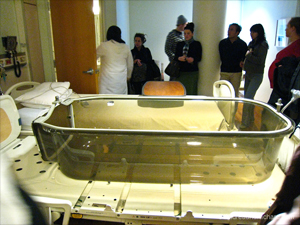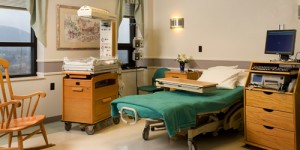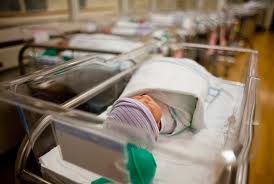Teacher Turned Student: Childbirth Education Class, Week Five
By: Kimmelin Hull, PA, LCCE | 0 Comments
Last week, I attended the final session of one of our local childbirth education classes. Beyond the hour-for-hour alternate credit I was able to log toward my Lamaze Continuing Education, I learned a heck of a lot along the way.
Last week's session was broken into two separate parts: a lengthy (and very good) discussion about breast feeding, and a tour of the hospital's L&D department. During the breastfeeding primer, we watched a great video, The Real Deal on Breastfeeding, which featured the expertise of IBCLC, Heather Kelly, as well as real moms discussing their challenges and achievements with breastfeeding. The hip, thorough and factual video did a great job describing the importance of achieving a good (perfect!) latch, sharing the benefits of breastfeeding for mom and baby, answering common questions and deconstructing certain myths about breastfeeding. Our class instructor followed the video with more discussion on latch, breastfeeding position, and the importance of getting the latch right 'from the very first time.'
On my way home from this last class, I had a chance to visit with a childbirth educator friend of mine. She asked me the same question that we've discussed between the two of us before: 'Do you think the hospital tour is helpful?' I found myself waffling on the answer - as I felt 'yes' and 'no' were both legitimate responses.
By the time an expectant mom/couple is attending a labor & delivery department tour, they are most likely within a few weeks of greeting their baby. They have (in most cases) firmly decided upon their location of labor and birth, as well as the provider (or provider group) with whom they will deliver. According to Childbirth Connection's Listening to Mothers I report, 88% of women who took childbirth classes attended them at a hospital, doctors' of midwives' office. It just makes sense, then, when attending class at the same facility in which you will give birth, to head on over to the L&D department and take a look around.
In fact, I still remember quite clearly the hospital tour my husband and I took, while approaching the due  date of our first child's birth. Similar to the L&D department tour I attended last week, we spent time in a labor and delivery room, ogling at the hospital bed that seemed almost gymnastic in its ability to move this way and that... the mound of pillows available in the fancy cupboards... the requisite birthing ball... the baby warmer, fetal monitor, IV stand and pain medication pump. The dads were more likely to zero in on the buttons and switches'clearly tempted by the Up & Down buttons on the bed, and the volume controls on the monitor. During the class I attended this week, we even received a demonstration of the 'Star Wars' overhead lighting - surgical spot lights that can be zeroed in on mom's perineum by a hand-held remote control.
date of our first child's birth. Similar to the L&D department tour I attended last week, we spent time in a labor and delivery room, ogling at the hospital bed that seemed almost gymnastic in its ability to move this way and that... the mound of pillows available in the fancy cupboards... the requisite birthing ball... the baby warmer, fetal monitor, IV stand and pain medication pump. The dads were more likely to zero in on the buttons and switches'clearly tempted by the Up & Down buttons on the bed, and the volume controls on the monitor. During the class I attended this week, we even received a demonstration of the 'Star Wars' overhead lighting - surgical spot lights that can be zeroed in on mom's perineum by a hand-held remote control.
As a first-time-expectant parent, I remember being ushered into the room of a second-time mother who'd given birth the day prior to our group's tour. I remember being in awe of her - sitting up in bed nice & comfy, calm and confident, discussing how well her baby's birth had gone. I recall making a mental note at that time: 'That's how I want to look and feel after our baby's birth.' My own confidence was boosted. My sense of calm: heightened. It prompted me to recollect a birth I had witnessed, as a Physician Assistant student some years before: a multiparous woman had come in from playing a round of tennis and delivered her baby a few hours later, medication-free and energized - rather than exhausted - from the experience.
 During last week's tour, we spent quite a bit of time in one of our hospital's larger, fancier L&D rooms. One of the moms in the class - who'd reported a recent up-tick in her Braxton Hicks contractions - was utilized as a sample patient. Our instructor invited her up onto the hospital bed and hooked her up to the monitor to demonstrate to the rest of the class how the fetal monitor worked and what each tracing represented. For the next half hour, the woman remained in the bed, monitor beeping away, while the instructor continued to point out various aspects of the room. I have to admit, it felt a little strange to be talking about a woman's 'freedom' to walk around during her labor - as long as she didn't go beyond the confines of the L&D unit - while the twelve of us remained static in that singular room. And, as the instructor admonished the class to 'try not to focus too much on the monitor during your labor,' it was awfully hard not to do just that - with one of our classmates at front & center stage, pink & blue belts wrapped around her belly, baby's heart beat echoing throughout the room.
During last week's tour, we spent quite a bit of time in one of our hospital's larger, fancier L&D rooms. One of the moms in the class - who'd reported a recent up-tick in her Braxton Hicks contractions - was utilized as a sample patient. Our instructor invited her up onto the hospital bed and hooked her up to the monitor to demonstrate to the rest of the class how the fetal monitor worked and what each tracing represented. For the next half hour, the woman remained in the bed, monitor beeping away, while the instructor continued to point out various aspects of the room. I have to admit, it felt a little strange to be talking about a woman's 'freedom' to walk around during her labor - as long as she didn't go beyond the confines of the L&D unit - while the twelve of us remained static in that singular room. And, as the instructor admonished the class to 'try not to focus too much on the monitor during your labor,' it was awfully hard not to do just that - with one of our classmates at front & center stage, pink & blue belts wrapped around her belly, baby's heart beat echoing throughout the room.
As we left the L&D unit for the postpartum area, I glanced at the doors leading to the OR. A computer printer sign was taped up on the door. 'Only ONE support person allowed into the OR with [the birthing woman.] NO EXCEPTIONS.' The twinge in my heart could have been heard in the next town over. Our local birth network has been trying for years to achieve a universal acceptance of doulas into the OR, so that mom (and dad) can receive the continuous emotional support they opted for when signing on with a doula in the first place. Myself included, several of us have achieved that goal in the past. And in all circumstances, our presence was not only appreciated by the birthing woman/parents, but by the hospital staff as well. Mom remained calmer'and not alone, after the baby was born and dad was across the room with his new son or daughter. (I still recall the last birth I attended in the OR with an extremely anxious mother who demanded that both her husband and I be with her during her surgical delivery. Silent tears streaming down her face, she continuously sought my eye contact and reassurance that 'all would be ok.') I can't help but believe that that type of emotional support has real consequences on things like blood pressure, pulse and oxygenation status'markers anesthesiologists are constantly monitoring during a Caesarean section.
The rest of the tour included a stop outside the nursery. Looking in at the few babes present there,  immediate post-birth procedures were reviewed again, with our instructor describing baby's first bath, Vitamin K & Hep B injections, eventual circumcision & a hearing test and the like. At some point she informed the class, 'we now even allow you to walk around this hallway with your baby, if you want to'just as long as you don't go past the unit secretaries' desk at the end of the hall!' I couldn't help questioning in my own mind: why shouldn't new parents be 'allowed' to walk around with their new child(ren)?
immediate post-birth procedures were reviewed again, with our instructor describing baby's first bath, Vitamin K & Hep B injections, eventual circumcision & a hearing test and the like. At some point she informed the class, 'we now even allow you to walk around this hallway with your baby, if you want to'just as long as you don't go past the unit secretaries' desk at the end of the hall!' I couldn't help questioning in my own mind: why shouldn't new parents be 'allowed' to walk around with their new child(ren)?
I really do think being able to visualize an up-coming event - including specifics of the surrounding atmosphere - is important. It's what athletes who subscribe to Sports Psychology practices are supposed to do in the days and hours leading up to an important sporting event.
But, again, I couldn't help paying attention to the subversive messaging: the baby warmer in the room was not countered by a discussion about the importance of skin-to-skin contact as being the 'optimal' baby warmer. (Thankfully, SSC was discussed as a beneficial tool in encouraging great breastfeeding from the very beginning.) The high-tech gadgets in the room exuded a stronger suggestion than that which any previous discussion on normal birth, and comfort and pain-coping methods could completely debunk.
I actually birthed two of my babies at the hospital I toured last week. Walking into one of the rooms in which I gave birth, brought back both visceral and surreal thoughts and feelings - many of which included my repeated actions to escape the confines of that environment (yes, in renegade fashion and still wearing my own clothing, I snuck outside the hospital doors on several occasions even after having been admitted in active labor - hiking a nearby hill in the August mid-day sun to progress my labor on my own!). From my highly intervened second birth, my memories were isolated to beeping machines, unnatural lighting and lots, AND LOTS of hours in an uncomfortable bed.
As last week's tour went on, I found myself hoping the expectant parents in the class would go home that evening and take a tour of their own familiar surroundings: considering what aspects of their house, their apartment, the street or garden outside their home they would spend time in during the early hours of labor. I hoped they would consider their kitchen in the same way our class passed by the water station and lollipop containers: thinking about how they would fuel their bodies during the early hours of labor and in preparation for the marathon ahead. I hoped they would consider their own beds, bathrooms and living rooms as equally fantastic environments to labor in - delaying their relocation to the hospital as long as possible. (One couple kept asking about the food situation at the hospital, and why mom was limited to just 'clear liquids' once at the hospital.)
Once a person has made an informed decision - such as where and with whom they will birth their baby - then feeling confident in that decision is important. And if attending a hospital L&D department tour is helpful in that sense of confidence - then I endorse it wholeheartedly. But I also think it's ok to continue asking questions - and if those questions lead you to more questions, and your original decision suddenly seems to hold less water than it did before, that's probably an acceptable process to follow through 'til its end.
A colleague of mine recently told me of an expectant couple who attended the hospital L&D tour more than once, prior to the birth of their second baby. It seems, they just really wanted to make sure it was the right setting for them. I applaud that diligence in decision making. If only everyone applied that much forethought and consideration to the 'where and with whom' pertaining to their up-coming birth experience.
After all, a baby is only born once.
Posted by: Kimmelin Hull, PA, LCCE
Published: May 21, 2011
Tags
Maternal Infant CareTeacher Turned StudentBreastfeeding Class TopicsHospital Labor And Delivery Tours